My dataset contains 2 variables y and t [05s]. y was measured every 05 seconds.
I am trying to calculate the average slope within a moving 20-second-window, i.e. after calculating the first 20-second slope value the window moves forward one time unit (05 seconds) and calculates the next 20-second-window, producing successive 20-second slope values at 05-second increments.
I thought that calculating a rolling regression with rollapply (zoo package) would do the trick, but I get the same intercept and slope values for each window over and over again. What can I do?
My data:
dput(DataExample)
structure(list(t = c(0, 0.05, 0.1, 0.15, 0.2, 0.25, 0.3, 0.35,
0.4, 0.45, 0.5, 0.55, 0.6, 0.65, 0.7, 0.75, 0.8, 0.85, 0.9, 0.95,
1, 1.05, 1.1, 1.15, 1.2, 1.25, 1.3, 1.35, 1.4, 1.45, 1.5, 1.55,
1.6, 1.65, 1.7, 1.75, 1.8, 1.85, 1.9, 1.95, 2, 2.05, 2.1, 2.15,
2.2, 2.25, 2.3, 2.35, 2.4, 2.45, 2.5, 2.55, 2.6, 2.65, 2.7, 2.75,
2.8, 2.85, 2.9, 2.95, 3, 3.05, 3.1, 3.15, 3.2, 3.25, 3.3, 3.35,
3.4, 3.45, 3.5, 3.55, 3.6, 3.65, 3.7, 3.75, 3.8, 3.85, 3.9, 3.95,
4, 4.05, 4.1, 4.15, 4.2, 4.25, 4.3, 4.35, 4.4, 4.45, 4.5, 4.55,
4.6, 4.65, 4.7, 4.75, 4.8, 4.85, 4.9, 4.95, 5, 5.05, 5.1, 5.15,
5.2, 5.25, 5.3, 5.35, 5.4, 5.45, 5.5, 5.55, 5.6, 5.65, 5.7, 5.75,
5.8, 5.85, 5.9, 5.95, 6, 6.05, 6.1, 6.15, 6.2, 6.25, 6.3, 6.35,
6.4, 6.45, 6.5, 6.55, 6.6, 6.65, 6.7, 6.75, 6.8, 6.85, 6.9, 6.95,
7, 7.05, 7.1, 7.15, 7.2, 7.25, 7.3, 7.35, 7.4, 7.45, 7.5, 7.55,
7.6, 7.65, 7.7, 7.75, 7.8, 7.85, 7.9, 7.95, 8, 8.05, 8.1, 8.15,
8.2, 8.25, 8.3, 8.35, 8.4, 8.45, 8.5, 8.55, 8.6, 8.65, 8.7, 8.75,
8.8, 8.85, 8.9, 8.95, 9, 9.05, 9.1, 9.15, 9.2, 9.25, 9.3, 9.35,
9.4, 9.45, 9.5, 9.55, 9.6, 9.65, 9.7, 9.75, 9.8, 9.85, 9.9, 9.95,
10, 10.05, 10.1, 10.15, 10.2, 10.25, 10.3), y = c(3.05, 3.04,
3.02, 3.05, 3.01, 3.02, 3.02, 3.05, 3.02, 3.01, 3.04, 3.04, 3.03,
3.03, 3.03, 3.02, 3.02, 3.03, 3.03, 3.03, 3.04, 3.03, 3.03, 3.03,
3.03, 3.02, 3.02, 3.02, 3.01, 3.03, 3.03, 3.03, 3.03, 3.03, 3.02,
3.01, 3.02, 3.02, 3.01, 3.02, 3.02, 3.02, 3.03, 3.02, 3.02, 3.01,
3.01, 3.02, 3.01, 3.02, 3.02, 3.02, 3.02, 3.01, 3.01, 3.01, 3.01,
3.02, 3, 3.01, 3.02, 3.02, 3.02, 3.01, 3.01, 3.01, 3.01, 3.02,
3, 3.01, 3.01, 3.01, 3.01, 3.01, 3.01, 3, 3, 3.01, 3, 3, 3.01,
3.01, 3.01, 3.01, 3, 3, 3, 3.01, 3, 3, 3.01, 3.01, 3.01, 3.01,
3.01, 3.01, 3, 3.02, 3, 3.01, 3.02, 3.04, 3.05, 3.08, 3.04, 3.06,
3.08, 3.06, 3.08, 3.09, 3.04, 3.05, 3.07, 3.08, 3.06, 3.08, 3.08,
3.07, 3.08, 3.08, 3.05, 3.06, 3.07, 3.07, 3.06, 3.08, 3.08, 3.08,
3.08, 3.08, 3.05, 3.06, 3.08, 3.08, 3.06, 3.09, 3.07, 3.08, 3.08,
3.08, 3.06, 3.07, 3.07, 3.07, 3.06, 3.09, 3.07, 3.07, 3.08, 3.08,
3.06, 3.07, 3.07, 3.07, 3.06, 3.09, 3.07, 3.07, 3.07, 3.08, 3.07,
3.07, 3.07, 3.07, 3.06, 3.08, 3.07, 3.07, 3.06, 3.08, 3.07, 3.07,
3.07, 3.07, 3.06, 3.08, 3.07, 3.07, 3.06, 3.08, 3.06, 3.07, 3.06,
3.07, 3.06, 3.08, 3.07, 3.07, 3.06, 3.07, 3.06, 3.07, 3.06, 3.07,
3.06, 3.07, 3.06, 3.06, 3.06, 3.07, 3.04, 3.04, 3.04, 3.06, 3.06,
3.04, 3.04)), class = c("tbl_df", "tbl", "data.frame"), row.names = c(NA,
-207L), .Names = c("t", "y"))
R-Code:
require(zoo)
library("zoo", lib.loc="~/R/win-library/3.3")
rollapply(zoo(DataExample),
width=5,
FUN = function(Z)
{
z = lm(formula=y~t, data = as.data.frame(DataExample));
return(z$coef)
}, by=1,
by.column=FALSE, align="right")


